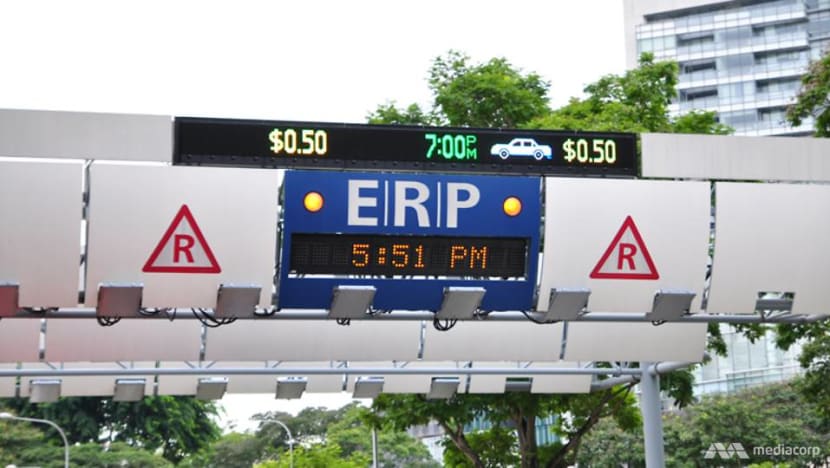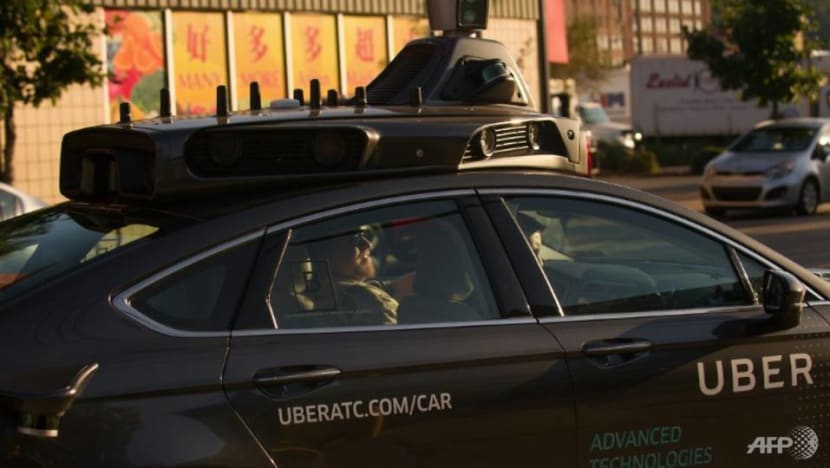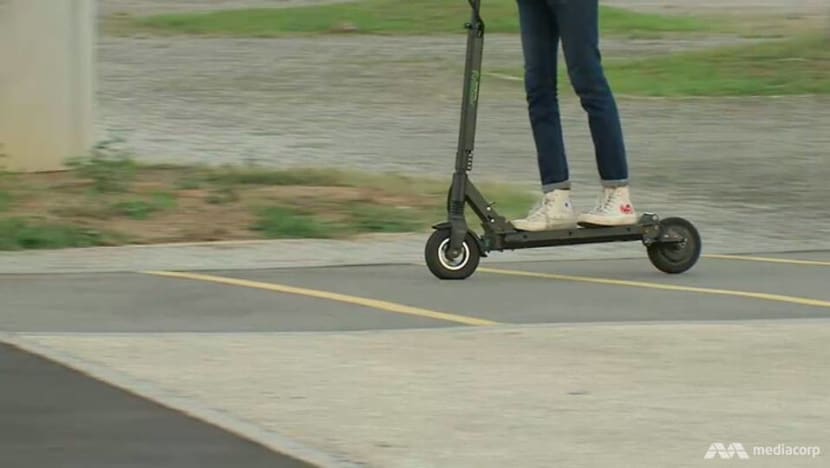commentary Commentary
Commentary: Ride-sharing should reduce congestion, not increase it
Policy makers should consider a redesign, says economist Jeffrey Funk.

Cars, motorcycles and heavy vehicles on Singapore roads. (File photo: CNA/Jeremy Long)
SINGAPORE: Singapore has one of the most respected transport systems in the world. Inexpensive and high-quality train and bus services, minimal road congestion, and widely available taxi and ride-sharing services make it one of the easiest cities to move around in the world.
Effective investments, electronic road pricing, and the certificate of entitlement (COE) are major reasons for Singapore’s transport success.
RIDE-SHARING AND ITS NEW CHALLENGES
Below the surface, however, new challenges are emerging from services such as vehicle, bicycle, and scooter-sharing.
Implemented in Singapore and elsewhere, ride-sharing has been very successful with US$61 billion in global revenues for 2018.
On the other hand, this growth has been driven by huge subsidies leading to big losses for start-ups in this space, not only in Singapore, but in the US, China, and India.
READ: Lessons from the fall of once-mighty bike-sharing giants
Grab, Uber, Lyft, Didi, and Ola have yet to make a profit and have accumulated heavy losses totalling about US$5 billion just in 2018 even though they have been providing services for five to 10 years. These losses are almost as large as their revenues suggesting their prices would double if subsidies were eliminated.
These heavy losses also suggest ride-sharing is not much better than existing taxi services, particularly those in Singapore where Comfort and other taxi suppliers have long offered bookings through apps, and before that, call-in services.
After all, the same types of vehicles, drivers and roads are used for both types of services and it is only algorithms that differentiate the two.
Contrast this small difference with that of e-commerce, a service that provides users with a huge value proposition, enabling consumers to bypass stores.

In the US, the stock market will decide over the next few months on whether investors think Lyft and Uber can reverse their losses and prove their services are better than existing taxi services.
Already, Lyft’s Initial Public Offering debut has met with a tepid response from investors leading to a 20 per cent decline in its stock price from a peak of US$85 (S$115) on the first day.
READ: The curious case of slick start-ups that tout billion-dollar valuations then rapidly collapse, a commentary
High losses for transport start-ups extends beyond vehicle-sharing to bicycle and scooter-sharing.
The world’s largest suppliers of bike-sharing services, Mobike and Ofo, are incurring heavy losses, and their retreat to China has left people with useless accounts and cities (including Singapore) with piles of bicycles to clean up.
Scooter-sharing is particularly problematic because they must be electrically charged, hence so-called dockless services are hard to implement.
READ: With Mobike’s impending exit, is it time to give public bike-sharing a shot? A commentary
POSSIBLE CONGESTION WOES
The other nasty fact about sharing services is that they often increase road congestion, particularly in the US and Europe.
Although Singapore’s COE and electronic road pricing may have constrained the impact of ride-sharing on congestion, further increases in ride-sharing - like those necessary for Grab, Gojek, and other newcomers to become profitable - would increase the number of cars on the road and thus congestion in Singapore.

READ: New York City adopts road congestion pricing, a commentary
Because ride-sharing vehicles must be on the roads to find new customers (and for drivers to take breaks and eat), their services will increase congestion even when their customers are switching from driving to riding.
Unlike ride-sharing, when you drive yourself, your vehicle is only on the road when you're commuting. Those switching from public transport to ride-sharing will increase congestion even more.
DRIVERLESS VEHICLES ARE YEARS AWAY
Proponents of ride-sharing argue that it and driverless cars will eventually reduce private car ownership and thus reduce the need for parking spaces, and that driverless cars will allow vehicles to travel more closely together thus increasing the capacity of roads.
Although there is some truth to these arguments, these proponents miss the fact that people will not sell their cars until ride-sharing and driverless vehicles become cheaper and widespread. At the same time, driverless vehicles will not enable cars to travel more closely together until most cars are driverless.
READ: Self-driving vehicles may encourage a new breed of distracted drivers, a commentary
It will take many years if not decades before driverless vehicles can handle every possible contingency and achieve fewer fatal accidents than conventional vehicles. Even many airline crashes, including the recent Boeing crash, are blamed on automation that reduces pilot attention.
TRAGEDY OF THE COMMONS
Proponents of ride-sharing and driverless vehicles overlook a key point about transport; it is built around free resources.

READ: You know who should study the Boeing 737 crashes? Driverless car makers, a commentary
Except for some roads in Singapore, cars travel for free on most roads, as do scooters and bicycles, even when the roads (and sidewalks) are adjacent to expensive high-rises in Singapore, London, or New York City.
Although Singaporeans do pay road taxes, those are independent of utilisation rates. When something is free, it will be used far too much, thus leading to high congestion.
There is even a term for this phenomenon; the tragedy of the commons. First used to explain how the unregulated grazing by domesticated animals on common land in England led to overgrazing in the early 1800s, it can be applied to any shared-resource system in which individuals pursue their own self-interest at the expense of the common good of all users.
Transport experts have understood this logic for decades and the fact that putting more cars on the roads of crowded cities leads to more congestion, whether the vehicles are used for taxi, ride sharing, or an owner’s private usage.
Even building more roads doesn’t help because there will still be bottlenecks in some places, though the places may change as more roads are built.
For instance, after above-ground highways were constructed in the US to bring more cars into downtown areas in the 1960s and 1970s, the downtown surface streets became more congested thus reducing the benefits of the highways.
TOO MANY ROADS AND PARKING PLACES?
This emphasis on building more roads to alleviate congestion is why roads and parking use 30 per cent to 50 per cent of surface space in most large cities and thus the real challenge for city managers over the last 50 years has been to reduce the need for this space.

This is now the challenge for transport-sharing, including car, bike, and scooter sharing. Just disrupting the taxi business is insufficient; these transport-sharing companies must reduce congestion in the short term and the amount of space dedicated to roads and parking in the long term.
Unfortunately, few entrepreneurs, venture capitalists, or even entrepreneurship professors have thought about these problems in much detail. Instead, many have become mesmerised by algorithms that will supposedly allocate work much more efficiently than humans can, despite evidence that algorithms have led to problems in many industries.
THINK CAREFULLY, USE DATA TO RESPOND FLEXIBLY
This does not mean that algorithms are not useful for transportation and other applications. It means that entrepreneurs, venture capitalists, public transport authorities and universities must think more carefully about the use of a common resource; in this case the land for roads, parking spaces, and even sidewalks.
READ: Shortening the waiting time for your cab with a driver guidance system, a commentary
Like I said at the start of this commentary, Singapore’s successful transport system comes from well-thought policies. It now needs to apply the same type of careful thinking to shared vehicles, bicycles and scooters to enact policies that will bring great benefits to Singaporeans.
For instance, algorithms can be used to devise better bus routes, including ones with fewer stops, thus reducing travel times, a key factor in generating demand for bus services.
GPS and smart phones mean that bus routes are no longer constrained by the memory of drivers or the size of bus stop information panels. Bus routes can change throughout the day as traffic patterns change, and users can follow these changes through their smart phones.

For example, early morning and evening commuting require certain types of bus routes while mid-day shopping, children returning home in mid-afternoon, and after-work entertainment require other types of bus routes.
TRANSFORMING URBAN TRANSPORT
With large amounts of data for places of living, employment, shopping, entertainment, and education, the Singapore government can identify new routes, routes that have fewer stops than the previous ones and that evolve over the course of a day.
Reducing the number of bus stops comes from understanding the real starting and ending points of passengers through data analysis.
Start-ups can also provide these services if the Government chooses to allow them, giving them the right to offer fixed-route services and the data to do so.
These types of services will likely have shorter travel times than existing public transport services for only slightly higher prices, and they will do far better than have services such as GrabShare or UberPool.

LISTEN: Impatient drivers and other threats on the roads, an episode on The Pulse podcast
Shared scooters and bicycles probably also have a role to play, perhaps in designated locations such as roads closed to cars and trucks. Doing this can also promote greater train usage if the designated locations are near train stations.
Singapore should not rest on its past successes. Vehicle, scooter, and bicycle-sharing and the technologies that form the basis of them provide big opportunities for further improvements to Singapore transportation system.
Singapore has the chance to again show the world that it is still the leader in urban transportation.
Jeff Funk is a retired Associate Professor and author of Technology Change and the Rise of New Industries.















